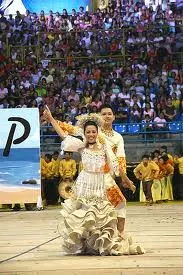On the global stage, the Bayanihan Dance Company has achieved a remarkable feat by clinching the top honors at the 22nd World Folk Dance Festival in Spain, emerging as the Grand Champion. This victory stands as a testament to the richness and vitality of our Filipino culture, a source of immense pride for every Filipino. Competing against 50 other delegations from Africa, Asia, Europe, and the Americas, their achievement is truly extraordinary.
This triumph not only highlights the exceptional talent and dedication of the Bayanihan Dance Company but also underscores the depth of our cultural heritage. It beckons us to delve deeper into our past, particularly in regions like Visayas and Cebu, where treasures from our ancestors await rediscovery. These legacies, often overlooked, hold precious insights into our identity and traditions.
As we celebrate this milestone, let us embrace the opportunity to rediscover and preserve our cultural heritage, ensuring that future generations can continue to take pride in our distinct traditions and contributions to global cultural diversity.
 |
| Sinulog Dance |
At the heart of the Sinulog is the tindera sinulog, performed by elder Cebuana women known as candle peddlers in the Basilica Minore del Sto. Niño Church. These dancers embody the prayers and petitions of devotees who purchase candles from them. The dance begins with an upright stance and a raised candle towards the image of Sr. Santo Niño, accompanied by recited prayers. With restrained yet pious movements originating from the torso, these motions flow gradually into wave-like gestures, concluding with another prayer.
Another interpretation of the Sinulog is the troupe sinulog, characterized by a more robust and energetic display. This version features vigorous movements such as jumping, hopping, and dynamic arm gestures, reminiscent of a spirited performance. Often seen during the grand mardi-gras parade and presentations of the Cebu Sinulog every January, this iteration is typically accompanied by drum and bugle corps, creating a unified rhythmic pulse.
However, variations in the Sinulog's traditional dance and beat are also embraced, particularly in the free interpretation category. Here, performers have the liberty to explore creative expressions while still paying homage to the festival's rich cultural origins.
The Sinulog remains not just a celebration, but a testament to Cebu's vibrant cultural heritage and its enduring spirit of devotion and festivity.
ITIK-ITIK
 |
| Itik-itik Dance |
 |
| Gapnod Dance |
Gapnod, or "flotsam" in Cebuano, commemorates a significant event in the town of Sibulan, Negros Oriental—the discovery of the image of St. Anthony de Padua by a fisherman. This worship dance is cherished among the locals, depicting scenes of rejoicing and culminating in a fluvial procession along the coast.
SURTIDO CEBUANO
 |
| Surtido Cebuano |
Originating from Bantayan, Cebu, Surtido Cebuano is a square dance that blends Spanish, Mexican, and French influences with indigenous elements. Traditionally performed by multiple pairs of dancers, with "cabeceras" leading and "costados" guiding, it features varied quadrille formations set to beautiful Visayan folk airs. While historically a dance of extended duration performed by large groups, modern renditions are more lively and suited for smaller gatherings.
 |
| La Berde |
La Berde, or "green," originates from a mountain settlement in Talamban, Cebu, and is a lively courtship dance. In a spirited series of quick steps and changes, the dance celebrates the lushness and vibrancy of life. Notably performed by two girls and a boy—a departure from the usual paired dancers—La Berde is often accompanied by another Visayan folk dance, Miligoy de Cebu.
MANANAGAT
Mananagat Dance
The Mananagat, meaning "fisherman" in Cebuano, is a mimetic dance that vividly portrays the life of fishermen at sea. Dancers, arranged in long-line formations, emulate women scooping water from canoes with bamboo shells and men skillfully maneuvering wooden paddles.
KURADANG
These dances not only preserve cultural traditions but also offer a vibrant glimpse into the rich tapestry of Philippine folklore, celebrating everyday life and significant milestones with grace, creativity, and joy.




















